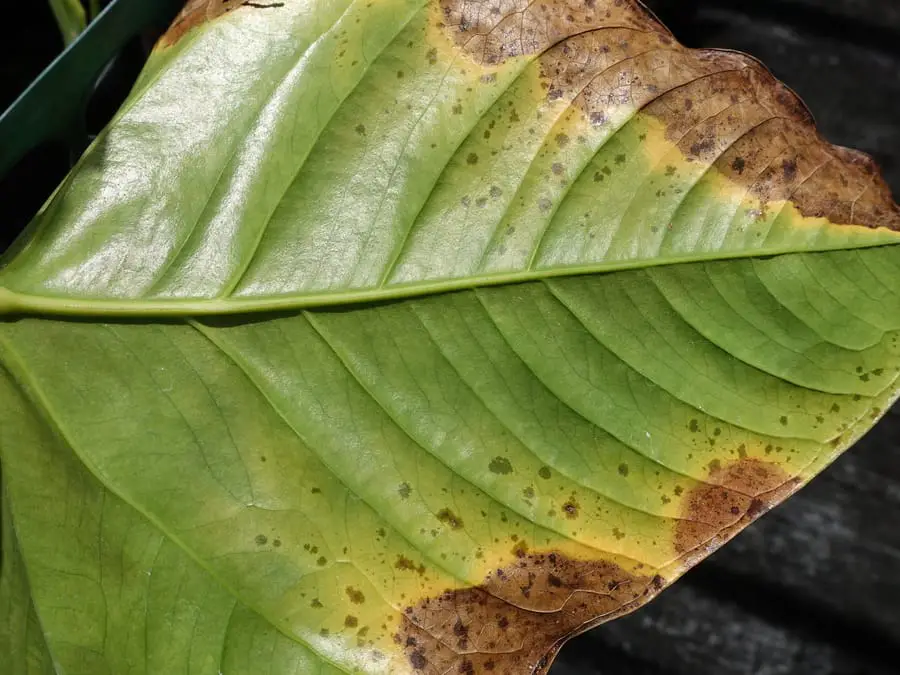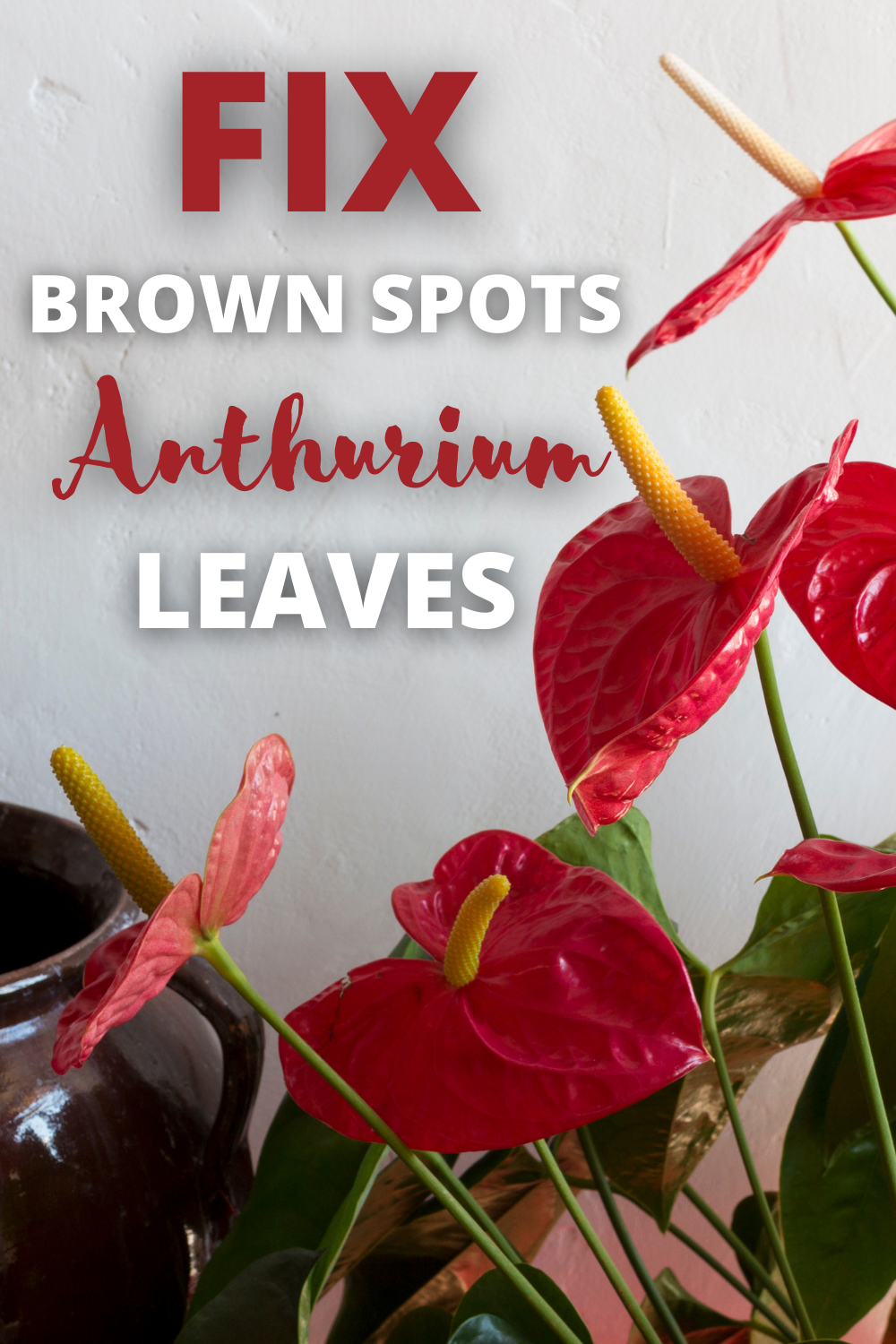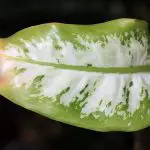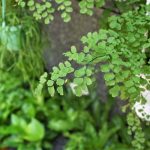
Anthurium (also known as flamingo flower) is a popular and relatively easy-to-grow tropical houseplant. While diseases are not common, occasionally the plant’s leaves can develop brown spots. After years of growing anthurium, we finally experienced this issue too. Not wanting to lose our plant, we learned what was wrong and what to do about it.
So, why do your anthurium leaves have brown spots? The most common reason is leaf blight (also known as leaf spot), caused by bacteria that infects the leaves. However, nutrient deficiency or too much sunlight may also cause brown spots. Here’s how to fix these problems and restore your anthurium to health.
Both bacterial diseases and nutrient deficiencies can be treated if you catch them early enough. It may not be too late to save your plant – especially if the brown spots are minimal and haven’t spread beyond the leaves.
Symptoms of Bacterial Leaf Blight
Bacterial leaf blight in anthurium plants cause:
- Yellow lesions darkening into necrotic brown spots
- Guttation droplets forming on the leaf margins
- Leaves with a bronze appearance
- Faded and spotted flowers (systemic infection)
Before brown spots form, you’ll notice yellow lesions along the leaf edges that rapidly turn into necrotic, v-shaped lesions. These lesions darken with age and eventually cause deformed leaves.
Small sap droplets will also be present on the leaves where the bacteria enter. These are known as guttation droplets, and they look like tiny drops of water forming on the leaf margins.
Guttation droplets typically form during the night when temperatures are warm, humidity around the plant is high, and the potting soil is wet. The amino acids found in the liquid provide food for the invading bacteria, which can then infect other nearby plants.
In some cases, it may take months for plants to show symptoms as the bacteria multiply on the leaves.
Once bacteria infect your anthurium leaves, they spread quickly throughout the entire plant. Leaves develop yellow then brown spots and may take on a bronze appearance. Flowers may become faded in color, and without treatment, the plant wilts and dies.
Causes of Leaf Blight
The bacteria that cause leaf blight infect the plant by entering through the pores along the leaf edges. Bacteria may also enter the leaves if they become damaged during pruning or are punctured in any other way. Even harvesting flowers or taking cuttings can cause wounds that allow bacteria to enter.
In addition, bacteria spread easily across wet surfaces. Getting foliage wet during watering is a major contributor to leaf blight. It’s important to keep the leaves dry in plants susceptible to bacterial diseases – like anthurium.
Watering your anthurium plants by placing six ice cubes on the soil and allowing them to melt once per week keeps the leaves from getting wet. It’s an inexpensive way of using the drip irrigation technique in your house plants.
Anthurium plants grown close to other aroid species – such as dieffenbachia, spahtiphyllum, or aglaonema – may become infected with blight. The bacteria known as Xanthomonas can infect most aroid species.
Contact with other infected plants or tools after pruning and harvesting will also spread the highly contagious disease. Simply touching an infected plant and then touching a healthy plant will spread the bacteria and infect the healthy plant.
Control and Treatment of Leaf Blight
If the entire plant is infected by leaf blight (known as systemic infection), you’ll have to destroy it to avoid spreading the disease to other plants. A systemically infected anthurium cannot be saved.
When only the leaves are infected, this is known as foliar infection. Plants with foliar infection may still be saved, as the bacteria hasn’t yet made its way into the vascular system.
The best way to control leaf blight in plants with foliar infection is to remove and burn any infected leaves. Do not cut them off with shears. It’s best to remove the leaves by breaking the petiole near the leaf blade. This helps prevent the bacteria from spreading further.
Some sources recommend using copper fungicides to control leaf blight. However, laboratory tests have shown the bacteria are resistant to copper, and application of these chemicals causes phytotoxicity.
There are several ways to prevent outbreaks of leaf blight in your anthurium plants, including:
- Keeping leaves dry at all times
- Watering directly into the soil or using drip irrigation
- Increasing air circulation around plants
- Keeping humidity between 70 and 80 percent
- Sterilizing shears and scissors used to harvest or prune plants
Disinfect tools – such as shears and scissors – after each use with a solution made of 70% alcohol. Submerge them completely in the solution for several minutes to ensure adequate disinfection of the cutting surface.
Nutrient Deficiencies
If you’re lucky, brown spots on your anthurium leaves may be caused by nutrient deficiencies instead of a bacterial disease. Leaves exhibiting yellow edges with a few brown spots – without the presence of guttation droplets – may indicate lack of nutrients.
Other symptoms of nutrient deficiency include:
- Reduction in plant growth
- Younger leaves with stunted growth (smaller than older leaves)
- New leaves light green in color and deformed
- Short, drooping stems
- Decreased flower production and size
It takes a long time for symptoms of nutrient deficiencies to appear. If you have a very young plant, this most likely isn’t the problem. But if you have an older plant that begins developing brown spots, it may just need a good feeding.
In an experiment performed by the University of Hawaii, anthurium did not exhibit symptoms until 9 – 18 months of sustained nutrient deficiency.
If you suspect this may be the cause of your plant’s brown spots, begin fertilizing with a high phosphorus fertilizer such as 15-30-15. The middle number indicates the level of phosphorus and should be higher than the first and last numbers.
Click here to see our favorite high-phosphorus anthurium fertilizer on Amazon. We’ve used it to successfully keep our plants healthy for many years.
Feed your plants once a month during the active growing season according to the directions on the label. If you have a major deficiency, feed once a week for 3-4 weeks and then cut back to once a month. Be careful not to over-fertilize or your plants may not produce blooms.
Too Much Sunlight

And finally, placing your anthurium in direct sunlight may also cause discolored or brown spotted leaves. Anthuriums are tropical plants native to South America. They thrive with bright, indirect light, but they cannot tolerate direct sun.
Anthurium does well in a west-facing window, where it will get bright afternoon sun. A south-facing window may be too harsh, and a north-facing window may not provide enough light.
If you aren’t sure if your plant is getting direct sunlight or not, see our article on direct sunlight through windows.
Related Questions
What are my anthurium leaves turning brown? Brown leaves are caused by too much sunlight, nutrient deficiency, or improper watering. Place your plant in bright, indirect sunlight (not direct sun), feed once a month during active growth with a high phosphorus fertilizer, and water once a week with six ice cubes or half cup of water.
How often does anthurium need to be watered indoors? For the best results, water anthurium houseplants once a week, allowing the soil to dry slightly between waterings. To prevent getting foliage wet – which can cause bacterial disease – place six ice cubes directly on the soil and allow them to melt or pour half cup of water directly into the soil.
See our complete Anthurium Indoor Plant Care Guide for more information on caring for your anthuriums and keeping them healthy.





